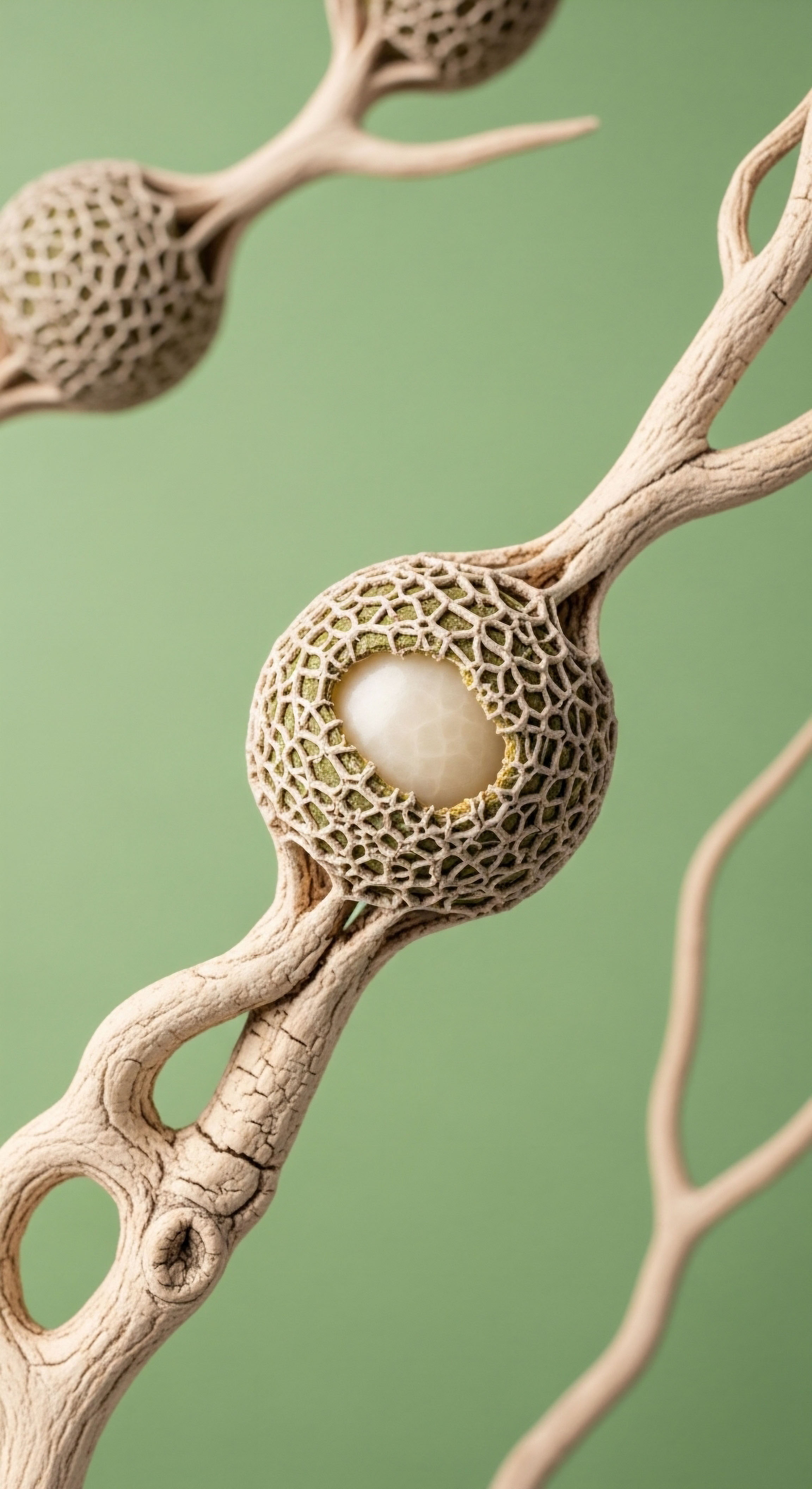

Fundamentals
The profound sense of exhaustion, the subtle yet persistent fog that clouds your thoughts, or the frustrating realization that your body is no longer responding the way it once did ∞ these are not failures of will. These are biological signals, messages from a complex internal communication network that is falling out of calibration.
Your lived experience is the primary data point in understanding your own health. It is the starting point of a journey toward reclaiming your vitality, a process that begins with understanding the language of your own body. At the heart of this language are two distinct yet interconnected classes of molecules ∞ hormones and peptides. Understanding their roles is the first step in moving from a state of managing symptoms to a state of commanding your own biological systems.
Hormones are the body’s long-range messengers, the powerful directives issued from the central command of your endocrine glands. Think of testosterone, estrogen, and thyroid hormones. These molecules travel through the bloodstream to every cell in your body, delivering instructions that regulate everything from your metabolic rate and mood to your reproductive health and bone density.
When these hormone levels decline, as they inevitably do with age, the signals become weak or distorted. The result is a system-wide cascade of effects that you perceive as symptoms ∞ fatigue, weight gain, low libido, and a general decline in well-being. Hormone replacement therapy, or more accurately, hormonal optimization, is a protocol designed to restore the clarity and strength of these essential signals, bringing your body’s foundational systems back into a state of functional balance.

The Body’s Internal Communication System
Your endocrine system operates as a sophisticated feedback loop, a constant conversation between your brain and your body. The Hypothalamic-Pituitary-Gonadal (HPG) axis, for instance, is the central regulatory pathway for sex hormones. The hypothalamus in your brain sends a signal (Gonadotropin-Releasing Hormone, or GnRH) to the pituitary gland.
The pituitary then releases Luteinizing Hormone (LH) and Follicle-Stimulating Hormone (FSH), which in turn signal the gonads (testes or ovaries) to produce testosterone or estrogen. When this axis functions optimally, the system is self-regulating. As we age, the signals can weaken at any point in this chain, leading to the hormonal deficiencies that so many adults experience. Biochemical recalibration aims to support this entire axis, ensuring the conversation between brain and body remains robust.
Hormonal optimization protocols are designed to restore the body’s foundational signaling pathways, addressing the root causes of age-related symptoms.
Peptides, on the other hand, are the body’s short-range, highly specific messengers. They are small chains of amino acids, the very building blocks of proteins. Unlike hormones that have broad, system-wide effects, peptides are specialists. They carry out precise tasks within specific tissues or systems.
For example, certain peptides act as growth hormone secretagogues, meaning they signal the pituitary gland to release your own natural growth hormone. This is a subtle yet powerful distinction. These peptides do not replace your body’s own output; they stimulate and refine it, encouraging a more youthful and efficient pattern of release. This targeted action can enhance tissue repair, accelerate fat loss, improve sleep quality, and support cellular health without the systemic impact of introducing a new hormone.

Distinct Roles in a Unified System
It is useful to conceptualize hormones as the body’s operating system, providing the background instructions that allow all other programs to run. Peptides are like specialized software applications that can be run to perform specific tasks, like repairing a corrupted file or optimizing system performance. Both are necessary for a fully functional system.
A person might have their testosterone levels optimized, which is akin to having a clean and powerful operating system. Yet, they may still experience slow recovery after exercise or poor sleep quality. This is where peptide therapy can provide a targeted enhancement, running a “repair and optimize” program that the hormonal operating system alone cannot execute. The two therapies work in concert, one providing the stable foundation and the other offering precise, targeted improvements.


Intermediate
Combining hormonal optimization protocols with targeted peptide therapy represents a sophisticated clinical strategy. It moves beyond addressing a single deficiency to creating a synergistic environment where the body can heal and function at its peak. The logic is grounded in a deep understanding of physiology ∞ hormones create the permissive environment for cellular activity, while peptides provide the specific signals that direct that activity.
When calibrated correctly, this combination can produce results that are far greater than the sum of their individual parts. This requires a nuanced approach, tailored to the unique biological landscape of each individual, whether male or female.

Protocols for Male Hormonal and Metabolic Optimization
For many men, the experience of andropause, or age-related testosterone decline, manifests as a loss of energy, decreased muscle mass, increased body fat, and a decline in cognitive focus. A standard protocol to address this involves Testosterone Replacement Therapy (TRT), typically using Testosterone Cypionate.
This restores the foundational androgenic signal that is essential for male physiology. However, a comprehensive protocol includes other agents to maintain the body’s natural endocrine balance. Gonadorelin is often used to stimulate the HPG axis, preserving testicular function and natural hormone production. Anastrozole, an aromatase inhibitor, is used judiciously to manage the conversion of testosterone to estrogen, preventing potential side effects like water retention.
This is where the integration of peptides becomes a powerful amplifier. While TRT restores the anabolic baseline, peptides can fine-tune the body’s response to that signal. The combination of CJC-1295 and Ipamorelin is a classic example. This pair works to stimulate a strong, natural pulse of growth hormone from the pituitary gland.
CJC-1295 provides a sustained increase in growth hormone-releasing hormone (GHRH) levels, while Ipamorelin delivers a potent, clean pulse without significantly impacting other hormones like cortisol. The result is an elevation in growth hormone and, subsequently, Insulin-Like Growth Factor 1 (IGF-1), which works alongside testosterone to maximize muscle protein synthesis, enhance lipolysis (fat breakdown), and improve recovery and sleep quality.

Table of Synergistic Protocols for Men
| Therapeutic Goal | Hormonal Component | Peptide Component | Synergistic Outcome |
|---|---|---|---|
| Muscle Gain & Fat Loss | Testosterone Cypionate (weekly) | CJC-1295 / Ipamorelin (daily) | Enhanced lean mass development and accelerated fat metabolism. |
| Visceral Fat Reduction | Testosterone Cypionate (weekly) | Tesamorelin (daily) | Targeted reduction of visceral adipose tissue, improving metabolic health. |
| Libido & Sexual Function | Testosterone Cypionate (weekly) | PT-141 (as needed) | Addresses both the hormonal (desire) and neurological (arousal) components of sexual health. |
| Fertility Preservation | Gonadorelin / Clomiphene | N/A (Peptides are generally used for other goals) | Maintains or restores natural testicular function during or after TRT. |

Protocols for Female Hormonal and Systemic Balance
A woman’s hormonal journey through perimenopause and post-menopause is characterized by fluctuations and eventual decline in estrogen and progesterone, often accompanied by a significant drop in testosterone. Hormonal optimization for women is a delicate recalibration process, often involving bio-identical estrogen and progesterone to manage symptoms like hot flashes, mood swings, and bone density loss.
A low, carefully monitored dose of Testosterone Cypionate is also a cornerstone of many female protocols, aimed at restoring energy, libido, and a sense of well-being that is often lost during this transition.
Integrating peptides into female hormonal protocols allows for targeted support of tissues and systems uniquely affected by menopause.
Peptide therapy in this context can be transformative. For instance, as estrogen levels decline, many women experience joint pain and a decrease in collagen, leading to skin laxity. The peptide BPC-157, known for its systemic healing and tissue repair properties, can be an invaluable addition.
It promotes angiogenesis (the formation of new blood vessels) and has potent anti-inflammatory effects, directly addressing the musculoskeletal complaints that often accompany menopause. Similarly, combining a growth hormone secretagogue like Sermorelin with a female HRT protocol can help counteract the metabolic slowdown and changes in body composition that are common during this life stage, supporting lean muscle mass and reducing fat storage.

What Are the Legal Frameworks Governing Peptide Use in China?
The regulatory landscape for peptides and hormone therapies varies significantly across different countries. In China, the regulations surrounding these substances are complex and evolving. While many hormones are available through prescription within the hospital system, the legal status of specific peptides for wellness or anti-aging purposes can be ambiguous.
The National Medical Products Administration (NMPA) maintains strict control over drug approvals. Any clinical application must be supported by robust data, and therapies considered “cosmetic” or “performance-enhancing” face a higher degree of scrutiny. Foreign practitioners and clinics operating in China must navigate a labyrinth of local and national regulations, and the importation of these substances is tightly controlled. Understanding these legal nuances is absolutely essential for any compliant and ethical clinical practice.
- Hormone Replacement Therapy ∞ Generally permissible under a physician’s care for diagnosed conditions like hypogonadism or menopausal symptoms. The specific formulations available are determined by the NMPA.
- Growth Hormone Peptides ∞ Peptides that stimulate growth hormone release, such as Sermorelin or Ipamorelin, often fall into a grey area. While recombinant human growth hormone (rHGH) itself is a controlled substance, the legal status of its secretagogues can be less clear and subject to regional interpretation.
- Cosmetic and Regenerative Peptides ∞ Peptides like BPC-157 or PT-141 are typically not approved as mainstream medical treatments and may be considered experimental or fall under regulations for cosmetic products, which have a different approval pathway.


Academic
An academic exploration of the synergy between hormone replacement and peptide therapy requires a shift in perspective from clinical outcomes to cellular and molecular mechanisms. The combination’s efficacy is rooted in the fundamental principles of endocrinology and cell biology ∞ the interplay between nuclear receptor activation and cell surface receptor signaling.
Hormones like testosterone and estrogen are lipophilic molecules that diffuse across the cell membrane and bind to intracellular receptors, forming a complex that translocates to the nucleus and acts as a transcription factor, directly altering the expression of target genes. This is a slow-onset, long-duration mechanism that fundamentally changes the cell’s protein synthesis machinery. It sets a new physiological baseline.
Peptides, particularly the growth hormone secretagogues, operate through a different, more immediate pathway. They are hydrophilic and bind to G-protein coupled receptors (GPCRs) on the cell surface, such as the Growth Hormone-Releasing Hormone Receptor (GHRH-R). This binding event triggers a rapid intracellular signaling cascade, typically involving adenylyl cyclase and the generation of cyclic AMP (cAMP), a second messenger.
This cascade ultimately leads to the phosphorylation of proteins and the release of pre-synthesized vesicles, such as those containing growth hormone in the somatotrophs of the pituitary gland. This is a rapid-onset, short-duration signaling event. The true synergy arises when these two distinct signaling paradigms converge on the same target cell or system.

Convergence of Anabolic Signaling Pathways
Consider the myocyte, or muscle cell, as a model system for this synergy. Testosterone, through its binding to the androgen receptor, directly upregulates the transcription of genes responsible for contractile proteins like actin and myosin. It also increases the expression of the IGF-1 receptor on the myocyte surface. This action primes the cell, making it more sensitive to anabolic signals. The cell’s machinery is ready and waiting for further instruction.
The peptide component, for example CJC-1295/Ipamorelin, stimulates the pulsatile release of growth hormone, which then travels to the liver and other tissues to stimulate the production of IGF-1. This circulating IGF-1 then binds to the now-upregulated IGF-1 receptors on the myocyte surface.
This binding activates the PI3K/Akt/mTOR pathway, a central regulator of cell growth and protein synthesis. The result is a powerful, coordinated anabolic drive. Testosterone builds the factory and staffs it with workers; IGF-1, stimulated by the peptides, delivers the raw materials and gives the order to begin production. The effect is multiplicative, not merely additive. The hormonal optimization creates a state of heightened anabolic potential, and the peptide therapy provides the acute stimulus to realize that potential.

Table of Cellular Mechanisms
| Molecule Class | Receptor Type | Signaling Pathway | Cellular Outcome | Time Course |
|---|---|---|---|---|
| Hormones (e.g. Testosterone) | Nuclear Receptor (Androgen Receptor) | Genomic / Direct Gene Transcription | Alters protein synthesis capacity | Slow (Hours to Days) |
| Peptides (e.g. CJC-1295) | G-Protein Coupled Receptor (GHRH-R) | Second Messenger (cAMP) | Triggers release of signaling molecules (GH) | Fast (Minutes) |
| Growth Factors (e.g. IGF-1) | Tyrosine Kinase Receptor (IGF-1R) | PI3K/Akt/mTOR Cascade | Stimulates protein synthesis and cell growth | Moderate (Minutes to Hours) |

Neuroendocrine and Metabolic Implications
This synergistic model extends beyond muscle tissue. In the central nervous system, both hormones and peptides play critical roles in neuronal function and mood. Estrogen is known to have neuroprotective effects and influence serotonin and dopamine levels. Testosterone has a clear impact on drive, motivation, and cognitive function.
Peptides can further modulate this environment. For example, GH secretagogues can improve sleep architecture, specifically slow-wave sleep, which is critical for synaptic pruning and memory consolidation. The resulting improvement in sleep quality can amplify the mood and cognitive benefits of hormonal optimization.
The interplay between hormonal and peptide signaling creates a multi-layered optimization of metabolic and neurological function.
Metabolically, the combination addresses health from two critical angles. Hormonal optimization, particularly with testosterone and thyroid hormones, sets the body’s basal metabolic rate and improves insulin sensitivity at a systemic level.
Peptides like Tesamorelin, a GHRH analogue, have been specifically shown in clinical trials to target and reduce visceral adipose tissue (VAT), the metabolically active fat surrounding the organs that is a key driver of systemic inflammation and insulin resistance. A protocol combining TRT with Tesamorelin would therefore improve the overall metabolic environment while simultaneously targeting one of the most dangerous and stubborn fat depots. This dual action provides a comprehensive strategy for mitigating age-related metabolic disease.

How Do Commercial Pressures Influence Clinical Protocols in China?
In China’s rapidly growing private healthcare market, clinical decisions can be influenced by commercial factors. The desire to offer the latest, most advanced treatments can lead to the promotion of combination therapies like HRT and peptides. High-end clinics often market these services as premium anti-aging or wellness packages.
This creates a commercial incentive to bundle services, which may or may not always align with the most conservative, evidence-based medical approach. Furthermore, the regulatory ambiguity of certain peptides can create a market where sourcing and pricing are opaque. Clinicians and patients must be discerning, prioritizing clinical need and safety over marketing trends. The pressure to generate revenue can sometimes conflict with the medical principle of using the minimum necessary intervention to achieve a therapeutic goal.
- Patient Demand ∞ A growing affluent class is actively seeking out advanced wellness and longevity treatments, creating a strong market pull for these therapies.
- Clinic Differentiation ∞ Private clinics use advanced protocols like combination peptide and hormone therapy to differentiate themselves from the public hospital system and attract a premium clientele.
- Supply Chain Influence ∞ The manufacturers and distributors of these therapeutic agents may also influence prescribing patterns through marketing, educational seminars, and partnership agreements with clinics.

References
- Veldhuis, J. D. & Weltman, A. (2012). The testicular ∞ hypothalamic ∞ pituitary ∞ gonadal axis. In Endocrinology ∞ Adult and Pediatric (6th ed. pp. 2155-2184). Saunders.
- Sigalos, J. T. & Pastuszak, A. W. (2018). The Safety and Efficacy of Growth Hormone Secretagogues. Sexual Medicine Reviews, 6(1), 45 ∞ 53.
- Molitch, M. E. Clemmons, D. R. Malozowski, S. Merriam, G. R. & Vance, M. L. (2011). Evaluation and treatment of adult growth hormone deficiency ∞ an Endocrine Society clinical practice guideline. The Journal of Clinical Endocrinology & Metabolism, 96(6), 1587-1609.
- Bhasin, S. Brito, J. P. Cunningham, G. R. Hayes, F. J. Hodis, H. N. Matsumoto, A. M. Snyder, P. J. Swerdloff, R. S. & Wu, F. C. (2018). Testosterone Therapy in Men With Hypogonadism ∞ An Endocrine Society Clinical Practice Guideline. The Journal of Clinical Endocrinology & Metabolism, 103(5), 1715 ∞ 1744.
- Stuenkel, C. A. Davis, S. R. Gompel, A. Lumsden, M. A. Murad, M. H. Pinkerton, J. V. & Santen, R. J. (2015). Treatment of Symptoms of the Menopause ∞ An Endocrine Society Clinical Practice Guideline. The Journal of Clinical Endocrinology & Metabolism, 100(11), 3975 ∞ 4011.
- Pickart, L. & Margolina, A. (2018). Regenerative and Protective Actions of the GHK-Cu Peptide in the Light of the New Data. International Journal of Molecular Sciences, 19(7), 1987.
- Falanga, V. & Carson, P. (2016). The potential of human growth hormone and other peptides in the treatment of wounds. Expert Opinion on Investigational Drugs, 25(10), 1147-1156.
- Giannoulis, M. G. Martin, F. C. Nair, K. S. Ferrando, A. A. & Sonksen, P. H. (2012). Hormone replacement therapy and the skeleton in elderly men and women. Endocrine Reviews, 33(3), 375-415.

Reflection
You have now explored the intricate biological dance between hormones and peptides, from foundational concepts to the deep cellular mechanics. This knowledge is a powerful tool. It transforms the conversation about your health from one of passive symptom management to one of active, informed biological negotiation. The path forward is one of personalization.
The data points in a lab report are secondary to the primary data of your own lived experience. The ultimate goal is to use these advanced clinical strategies to create a physiological environment that allows you to function with the vitality and clarity that you deserve. This information is the map; your journey requires a guide who can help you navigate the unique terrain of your own body.



